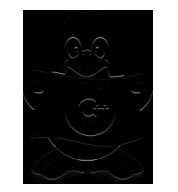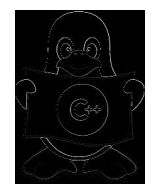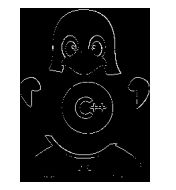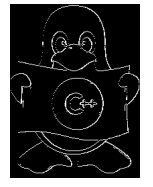OpenCV小项目:自实现 Canny 算子
文章目录
- 实现步骤
-
- 高斯滤波
- 一阶偏导有限差分计算梯度幅值和方向
-
- 计算梯度
- 计算幅值和相角
- 非极大值抑制
-
- 具体措施
- 双阈值算法检测和连接边缘
- 实现代码
- 实验结果
实现步骤
- 用高斯滤波器平滑图像
- 计算滤波后图像梯度的幅值和方向
- 对梯度幅值应用非极大值抑制,其过程为找出图像梯度中的局部极大值点,把其它非局部极大值点置零以得到细化的边缘
- 用双阈值算法检测和连接边缘,使用两个阈值 T1 和 T2(T1>T2),T1 用来找到每条线段,T2 用来在这些线段的两个方向上延伸寻找边缘的断裂处,并连接这些边缘
高斯滤波
由高斯滤波器的二维可分性(X 轴与 Y 轴方向进行高斯滤波互不干扰),代码采用两次 1*5 一维高斯滤波器 [ 1 , 4 , 6 , 4 , 1 ] [1, 4, 6, 4, 1] [1,4,6,4,1]对 X、Y 方向分别进行卷积(对 Y 方向需要先转置再卷积,之后再转置回来)以实现 5*5 二维高斯滤波器。由于可将一维高斯滤波器封装为一个函数 SingleGaussFilter,简化了代码量和程序复杂度
一阶偏导有限差分计算梯度幅值和方向
计算梯度
以实现
P [ y , x ] ≈ 1 2 ( S [ y , x + 1 ] − S [ y , x ] + S [ y + 1 , x + 1 ] − S [ y + 1 , x ] ) P[y, x]\approx \frac{1}{2}(S[y,x+1]-S[y,x]+S[y+1,x+1]-S[y+1,x]) P[y,x]≈21(S[y,x+1]−S[y,x]+S[y+1,x+1]−S[y+1,x])
Q [ y , x ] ≈ 1 2 ( S [ y + 1 , x ] − S [ y , x ] + S [ y + 1 , x + 1 ] − S [ y , x + 1 ] ) Q[y, x]\approx \frac{1}{2}(S[y+1,x]-S[y,x]+S[y+1,x+1]-S[y,x+1]) Q[y,x]≈21(S[y+1,x]−S[y,x]+S[y+1,x+1]−S[y,x+1])
计算幅值和相角
幅值计算式
M [ y , x ] = P [ y , x ] 2 + Q [ y , x ] 2 M[y, x]=\sqrt{P[y,x]^2+Q[y,x]^2} M[y,x]=P[y,x]2+Q[y,x]2
相角计算式
θ [ y , x ] = a r c t a n Q [ y , x ] P [ y , x ] \theta[y,x]=arctan\frac{Q[y,x]}{P[y,x]} θ[y,x]=arctanP[y,x]Q[y,x]
非极大值抑制
由于得到梯度之后,仍存在双边缘、宽边缘和噪声点等影响,若直接进行阈值分割确定边缘,结果并不理想。为解决宽边缘问题,可以将整条边缘认为是一条山脉,而真边缘则为山脊,故尝试采用局部极大值抑制,只保留 3*3 邻域且特定方向内的极大值,以消除非山脊的山脉影响
具体措施
- 依据相角 [ − 9 0 ∘ , + 9 0 ∘ ] [-90^\circ,+90^\circ] [−90∘,+90∘]将梯度角的变化范围减小到圆周的四个扇区之一( [ − 22. 5 ∘ , + 22. 5 ∘ ] [-22.5^\circ,+22.5^\circ] [−22.5∘,+22.5∘]对应 0 区, [ − 67. 5 ∘ , − 22. 5 ∘ ] [-67.5^\circ,-22.5^\circ] [−67.5∘,−22.5∘]对应 1 区, [ + 22. 5 ∘ , + 67. 5 ∘ ] [+22.5^\circ,+67.5^\circ] [+22.5∘,+67.5∘]对应 3 区, [ − 9 0 ∘ , − 67. 5 ∘ ] [-90^\circ,-67.5^\circ] [−90∘,−67.5∘]和 [ + 67. 5 ∘ , + 9 0 ∘ ] [+67.5^\circ,+90^\circ] [+67.5∘,+90∘]对应 2 区),而每一个扇区对应着当前点 8 邻域的 4 个方向
- 将每一点与沿着梯度线方向的两个象素比较,若当前点梯度值 ≥ \geq ≥沿梯度线的两个相邻象素梯度值,则令保留当前点不变;否则,置 0
双阈值算法检测和连接边缘
由于设置单一阈值,在调节阈值大小的同时,真实边缘的增多往往伴随着虚假边缘和噪声点的增多,而将阈值提高减少虚假边缘和噪声点的同时,会造成边缘轮廓丢失的问题。为解决这个矛盾,采用双阈值分割算法,通过低阈值将所有可能边缘检测出来,利用高阈值检测出所有真边缘(可能有部分轮廓丢失),则可以利用高阈值图像作为种子点,索引出所有在低阈值图像上的所有相邻点,以补全高阈值图像,来实现抑制噪声和虚假边缘,同时减少真边缘丢失的目的
实现代码
#include 实验结果
原图
灰度图
高斯滤波
X方向梯度
Y方向梯度
梯度
非极大抑制
高阈值梯度图
低阈值梯度图
低高阈值相减梯度图
自己实现的Canny结果












